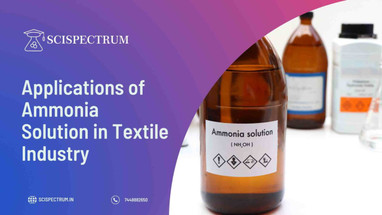Posted by Scispectrum on 22nd Aug 2025
Ammonia Solution in the Textile Industry: A Versatile Chemical with Diverse Applications
The Ammonia Solution in the Textile Industry relies heavily on chemical processes to transform raw fibers into the fabrics and garments we use every day. Among these essential chemicals, ammonia solution (NH4OH) stands out as a versatile workhorse, playing a crucial role in various stages of textile production.
This article explores the diverse applications of ammonia solution in the textile industry, delving into its benefits, considerations for safe handling, and the ongoing search for sustainable alternatives.
Understanding Ammonia Solution and Its Properties
Ammonia solution, also known as ammonium hydroxide, is a colorless liquid with a pungent, characteristic odor. It’s created by dissolving ammonia gas (NH3) in water, resulting in an alkaline solution with a high pH. This alkalinity, coupled with ammonia’s unique chemical properties, makes it invaluable for various textile processing steps.
Key Applications of Ammonia Solution in Textile Manufacturing
- Pretreatment and Scouring:
- Cotton Scouring: Ammonia solution effectively removes natural waxes, oils, and impurities from cotton fibers, enhancing their absorbency and preparing them for subsequent dyeing and finishing processes.
- Wool Treatment: In wool processing, ammonia solution helps modify the fiber’s scales, improving its softness, luster, and dye uptake.
- Silk Degumming: Ammonia solution plays a vital role in degumming silk, removing the gummy sericin protein that coats silk fibers, enhancing their softness, drape, and shine.
- Dyeing and Printing:
- Dye Uptake Enhancement: Ammonia solution swells certain fibers, like cotton, increasing their porosity and allowing for better penetration and fixation of dyes, leading to more vibrant and long-lasting colors.
- Color Fixing Agent: Ammonia acts as a color fixing agent in some dyeing processes, reacting with dyes to form insoluble compounds that remain firmly attached to the fibers, improving colorfastness.
- Reactive Dyeing: Ammonia solution is crucial in reactive dyeing, a process commonly used for cellulosic fibers like cotton. It helps create the alkaline conditions necessary for the reactive dyes to form strong chemical bonds with the fibers, resulting in exceptional wash and rub fastness.
- Denim Washing and Finishing:
- Stone Washing Effects: Ammonia solution is used in denim processing to achieve the sought-after faded look and soft hand-feel. It reacts with the indigo dye, breaking down some of the dye molecules and creating the characteristic faded appearance.
- Neutralizing Acid Wash: After acid washing denim, ammonia solution is used to neutralize the residual acid, preventing damage to the fabric and ensuring a safe and comfortable garment.
Benefits of Using Ammonia Solution in Textile Processing
Several factors contribute to the widespread use of ammonia solution in the textile industry:
- Effectiveness: Ammonia solution excels in its various applications, from fiber pretreatment to dyeing and finishing, delivering consistent and reliable results.
- Versatility: Its ability to interact with various fibers and dyes makes it a highly versatile chemical for diverse textile processing needs.
- Cost-Effectiveness: Compared to some alternative chemicals, ammonia solution is often a more economical choice for textile manufacturers.
Considerations for Safe Handling and Environmental Responsibility
While ammonia solution offers numerous benefits, it’s crucial to handle it with care and address potential environmental concerns:
- Safety Precautions: Ammonia solution is corrosive and can irritate the skin, eyes, and respiratory system. Proper ventilation, personal protective equipment (PPE), and safe handling procedures are essential to protect workers.
- Wastewater Treatment: Discharging ammonia-laden wastewater into the environment can harm aquatic life and disrupt ecosystems. Textile facilities must implement effective wastewater treatment methods to remove ammonia before discharge.
- Sustainable Alternatives: The textile industry is actively exploring and adopting more sustainable alternatives to ammonia solution, driven by environmental regulations and a growing emphasis on eco-friendly practices. These alternatives include enzymes, bio-based solvents, and electrochemical treatments, offering promising solutions for specific textile processes.
Conclusion: Balancing Performance and Responsibility
Ammonia solution remains a vital component of the textile industry, enabling the creation of a wide array of fabrics and garments. As the industry evolves, balancing the benefits of ammonia solution with responsible handling practices and the exploration of sustainable alternatives will be crucial for ensuring both high-quality textile production and a healthier planet.

